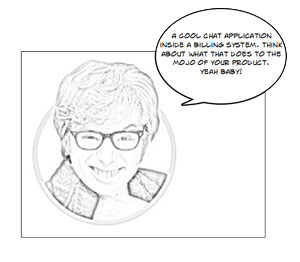If you have ever worked on anything that was used by more than one user, for more than a few days of their lives, you probably get a truck load of hugely random and weird feature requests at work. If you have worked with a bunch of marketing and sales folks responsible for demoing your product to 'potential customers' you probably know this even better.

I have talked about avoiding the Perils of Demo Driven Development through heavy use of YAGNI before. But then having said that, every once in a while, a random critic will convince your marketing and sales team that if you could just build that chat application that allowed the point-of-sales team to interact with each other and integrate it with your billing system your billing system will sell like hotcakes.
If you have ever thought of giving in to temptation and building stuff that the competition is building just so that your product could compete with your competition, Paul Buchheit of Gmail has sensible word of advice for you. He explains:
I believe this "more features = better" mindset is at the root of the misjudgment, and is also the reason why so many otherwise smart people are bad at product design (e.g. most open source projects). If a MacBook with OSX and no keyboard were really the right product, then Microsoft would have already succeeded with their tablet computer years ago. Copying the mistakes of a failed product isn't a great formula for success.
What's the right approach to new products? Pick three key attributes or features, get those things very, very right, and then forget about everything else. Those three attributes define the fundamental essence and value of the product -- the rest is noise. For example, the original iPod was: 1) small enough to fit in your pocket, 2) had enough storage to hold many hours of music and 3) easy to sync with your Mac (most hardware companies can't make software, so I bet the others got this wrong). That's it -- no wireless, no ability to edit playlists on the device, no support for Ogg -- nothing but the essentials, well executed.
We took a similar approach when launching Gmail. It was fast, stored all of your email (back when 4MB quotas were the norm), and had an innovative interface based on conversations and search. The secondary and tertiary features were minimal or absent. There was no "rich text" composer. The original address book was implemented in two days and did almost nothing (the engineer doing the work originally wanted to spend five days on it, but I talked him down to two since I never use that feature anyway). Of course those other features can be added or improved later on (and Gmail has certainly improved a lot since launch), but if the basic product isn't compelling, adding more features won't save it.
On his assessment on whether iPad is a great product or not, or if all the critics shouting at the top of their voice about the lack of features in the iPad are justified in doing so or not, Paul gives useful advice to young and budding product designers. He explains:
By focusing on only a few core features in the first version, you are forced to find the true essence and value of the product. If your product needs "everything" in order to be good, then it's probably not very innovative (though it might be a nice upgrade to an existing product). Put another way, if your product is great, it doesn't need to be good.
Making the iPad successful is Apple's problem though, not yours. If you're creating a new product, what are the three (or fewer) key features that will make it so great that you can cut or half-ass everything else? Are you focusing at least 80% of your effort on getting those three things right?
If you are working on a product, go ahead. Pick those three small and simple things which your product is supposed to achieve. Write them down in easy to understand sentences on a whiteboard. Now, do some serious soul searching on if your product does these three things flawlessly. Is your product the best in the world at doing these three things? With consistent effort and hard work, can it become the best in the world at doing these three things?
If you answered no, adding features to your product will not help. If you answered yes, put in that consistent effort and hard work to make your product a great product, because if it is a great product, you won't have to slog your ass to make it a good product.
I wish you good luck.
Comments are closed.